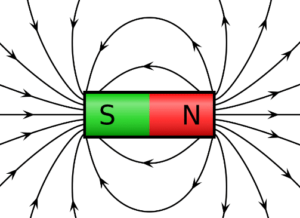Magnetic flux and magnetic flux density
 The group of force lines going from the north pole to the south pole of a magnet is called the magnetic flux, symbolized by Φ (the Greek letter phi). The number of lines of force in a magnetic field determines the value of the flux. The more lines of force, the greater the flux and the stronger the magnetic field.
The group of force lines going from the north pole to the south pole of a magnet is called the magnetic flux, symbolized by Φ (the Greek letter phi). The number of lines of force in a magnetic field determines the value of the flux. The more lines of force, the greater the flux and the stronger the magnetic field.
The unit of magnetic flux in the Weber (Wb). One whole equals 108 lines. Weber is a very large unit; thus, in most practical situations, the microweber (μWb) is used. One microweber equals 100 lines of magnetic flux.
Magnetic Flux Density formula
The magnetic flux density is the amount of flux per unit area perpendicular to the magnetic field. Its symbol is B, and its SI unit is the Tesla (T). One tesla equals one weber per square meter (WB/m2). The following magnetic density formula expresses the flux density.

Where Φ is the flux and A is the cross-sectional area in square meters (m2) of the magnetic field.
See also: Difference between electric field and magnetic field
The Gauss
Although the Tesla (T) is the SI unit for the unit for flux density, another unit is called the gauss, from the CGS (centimeter-gram-second) system, which is sometimes used (104 gausses = 1 T). In fact, the instrument used to measure flux density is the gaussmeter.
For related topics visit our page: Electricity and Magnetism
